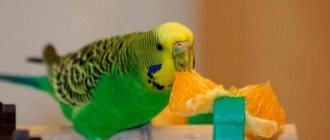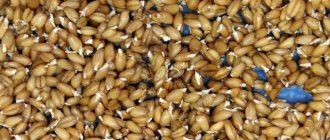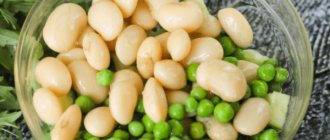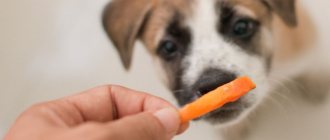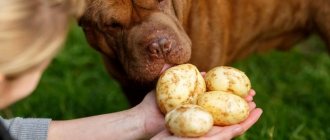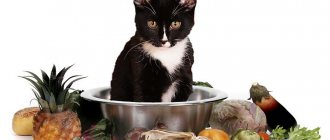Rabbits are bred to produce tasty dietary meat and valuable fur. Some decorative individuals feel great as pets. All owners of furry animals sooner or later become interested in the issue of proper feeding of rodents. What grass can be given to rabbits, in what quantity and what to combine it with, worries everyone who wants to have healthy and strong animals.
Rabbits eat food exclusively of plant origin. Summer is the ideal time to fully feed these animals. During this period, you can find a sufficient number of different herbs both in forests, meadows and fields, and in your own gardens. Rabbit owners need to know which plants are especially useful for full development, and which can harm the weak digestive system of rodents.
Note! By including forbs in the diet of rabbits, you can significantly reduce the consumption of feed and grain crops. This will have an impact on reducing the cost of meat and fur.
What grass can you give to rabbits?
What grass can rabbits eat?
To properly feed rabbits, it is necessary to use green grass, leaves and fresh tree shoots throughout the entire season - from early spring to late autumn. Summer is the ideal time to fully feed these animals.
During this period, you can find a sufficient number of different herbs both in forests, meadows and fields, and in your own gardens. This approach also has an economic basis, since it allows you to reduce the amount of grain feed, and therefore products from rabbits will cost much less.
Rabbits should be fed green food from early spring to late autumn. Numerous herbs contain nutritional components and vitamins, and also have medicinal effects. Grass for rabbits has a beneficial effect on the functioning of the digestive system, improves the quality of the coat and accelerates the growth of the animal.
Rodents, which include rabbits, best absorb and digest grain feed. It contains all the components necessary for life and growth:
How to make and store hay?
The best mixture of grasses for hay is legume-cereal, alfalfa, clover, bluegrass, timothy, and wheatgrass.
For hay, grasses are chosen before flowering and even before buds set, in clearings, hillocks, in dry and sunny places. These should be wild areas of meadows, steppes and forests away from roads and other sources of pollution, or personal lands.
They cut the hay in clear weather and leave the grass right there on the ground to dry. It cannot be kept in the sun for a long time, so after a couple of hours the hay is collected and dried under a canopy. Properly prepared, it retains its green color and pleasant, fresh smell.
In households, hay is stored in barns, haylofts, on wooden floors, in stacks or stacks. Main conditions: shade, dryness, ventilation. On farms, it is prepared into bales or grass briquettes to minimize the loss of leaves during distribution and consumption.
Medicinal herbs for rabbits are collected, dried briefly in the sun, then tied into small brooms (so that the stems do not rot inside), which are dried under a canopy in the attic, and stored in the brooms.
How to dry medicinal herbs for rabbits
Beneficial properties of herbs
Grasses appear in early spring and disappear in late autumn with the first frost. The benefits of green feed are quite great:
- They are well digested and quickly absorbed by rabbit stomachs.
- The fiber found in greens (especially those mowed late) has a beneficial effect on the digestive system of domestic herbivores.
- The growth of animals is stimulated.
- Fresh grass is a source of vitamins and nutritional components for rabbits.
- The quality of their wool improves.
Properly selected herbal food strengthens the pet’s immunity and promotes the growth and development of young animals. The consumption of certain types of herbal plants nourishes the animal’s body with various substances and elements necessary for its health, which include:
- vitamins;
- minerals;
- proteins.
Also, decorative rabbits can be given various salads, except lettuce. We also recommend watching a video that tells you how to grow grass for your pet rabbit in winter (in a tray on the windowsill).
Tip: Using green herbs to feed rabbits, you can reduce the amount of grains and feed in the diet by half. This will have a positive impact on the cost of the resulting meat, fluff and fur skins.
The table discusses what herbs can be fed to rabbits without fear for their health, and also notes the nuances of their preparation.
| Herb name | Beneficial features | Secrets of collection and preparation |
| Dandelion officinalis |
| Dandelions are best given in combination with other herbs, but not more than 30% of the total. Exceeding the volume of feeding dandelions to rabbits leads to growth retardation. |
| Siberian hogweed |
| Grows in forest clearings between bushes. It begins to bloom in June-July. Only leaves are used as food for rabbits. |
| Nettle |
| Nettles are given fresh (without flowers) and stored for the winter. When used as green mass, leaves and stems are scalded with boiling water, crushed and added to dry food. Nettle hay is fed to pregnant females in the spring. Nettle leaves collected in late June - early July have a medicinal effect. |
| Coltsfoot |
| Coltsfoot plants begin to produce green mass from mid-May. Harvesting for the winter begins in June. Leaves, flowers and roots are dried. |
| Wheatgrass |
| Leek rhizomes are used as feed, which must be thoroughly washed. Dried rhizomes are stored in a jar for 2-3 years. |
| Plantain |
| Grows on roadsides, in meadows and field boundaries. |
| Sagebrush |
| In the fall, by eating wormwood, rabbits cleanse their bodies of worms. Consumption of a large amount of wormwood (with its share in the feed structure of more than 40%) causes nervous excitement in rabbits. |
How to make the right choice
However, you should not think that all herbs are equally useful; when choosing, it is very important not to make a mistake, otherwise you can greatly harm the animal’s body. Thus, seeded species, in particular alfalfa, can be used as feed. However, this method of feeding cannot be called economical, but it is precisely for the sake of economy that you need to use wild plants; they grow in large quantities in meadows, forests, fields, and what can I say, even in most vegetable gardens. You should also know that green herbs perfectly compensate for grain feed and compound feed. This is very important when taking into account the cost of meat and fur.
See also: Can I feed rabbits bananas or banana peels?
Now it is very important to understand (especially for novice rabbit breeders) what kind of grass can be fed to long-eared pets. It is preferable to feed grass that is still young, since it contains a large amount of protein, but little fiber. If you use plants that are already in the last stages of growth for food, then you need to take into account that most of the nutrients are no longer in them, but on the contrary, there is an order of magnitude more fiber there, and this is the reason for poor digestion.
Animals, like people, need variety in their diet, so you shouldn’t feed them the same grass for a long time. Varied green food is consumed by the animals with great eagerness. If the grass has just been mowed and there are still traces of morning dew on it, then you don’t need to give it to the animals right away, it’s better to dry it slightly, this way it will be much better absorbed by the rabbit’s body.
So, we still need specifics about what herbs can be given to long-eared pets so that there is no concern for their health. It is also important to pay attention to some procurement aspects.
Attention - dangerous herbs!
Eating some herbs in your rabbit's diet can be detrimental to your pets if you don't know which ones are dangerous or poisonous. In addition to edible herbs, quite a large number of dangerous plants grow on lawns, parks, fields and forests. Here is a list of plants that should be avoided:
- Jasmine and poppy are ornamental herbs that cause various ailments.
- Buttercups. Disturbs the functioning of the stomach. Causes diarrhea, vomiting, excessive salivation. The stomach swells when poisoned.
- Euphorbia - it causes animals to vomit.
- Dream-grass. There is simply a full range of negative consequences - paralysis, convulsions, and interruptions in the functioning of the heart. Causes diarrhea and other intestinal disorders.
- Horned cornflower. Negatively affects the ventricles of rabbits. It causes both diarrhea and vomiting. If you eat too much of it, paralysis may occur.
- Datura. In addition to paralysis, it can cause interruptions in the functioning of the heart muscle.
- Veh is poisonous. It also causes anxiety and convulsions in animals, as well as paralysis of the respiratory tract.
- Hemlock. A very poisonous plant, from which the rabbits’ temperature drops, convulsions occur, and complete paralysis can occur.
- Swamp whitewing. It is found mainly in wetlands. When consumed as food, it causes bloating in animals, excessive salivation and general nervousness.
- Indoor plants such as begonia and azalea, amaryllis, etc.
- Great celandine. Weakens the body of animals, reduces appetite, makes them lethargic.
- Marigold. Causes rabbits to urinate frequently, causing colic and vomiting.
- Avran. Inflames the intestinal mucosa.
- Digitalis. It makes the animals’ hearts work faster, resulting in shortness of breath, arrhythmia, and convulsions.
- Frozen or canned green mass.
You should not feed animals greens collected from the sides of large and busy roads - the dust and exhaust gases they contain can lead to digestive disorders. As a last resort, it is necessary to thoroughly rinse such grass.
How not to poison a rabbit
If your rabbit is very small, limit any greens. The same red clover, loved by rabbits, can cause stomach upset in young animals: these animals really eat clover with pleasure and do not limit the amount of it, while the digestive system of young rabbits is not yet able to cope with a large volume of fresh green food.
A big misconception is also the abundance of dandelions in a rabbit’s diet. Dandelions are healthy, and animals eat them willingly, but it is better to make such plants an addition to lunch, rather than the main dish. The same should be done with yarrow and rapeseed. Salsify, geranium and spurge should not be given to young animals at all, and adult rabbits should limit their use.
In small quantities, given as a mixture with other plants and types of food, all of these herbs are beneficial for an adult rabbit and will help diversify its diet.
You can bring beet tops to your rabbit from your summer cottage, but they can cause digestive upset if the diet is unbalanced. Therefore, along with it, it is worth putting thin fresh branches of alder or oak into the cage: astringents will “neutralize” the greenery.
Dog parsley, nightshade, and buttercup are poisonous when fresh or dried. However, if you find them among the hay, there is no need to worry; when dried, these plants are harmless to the rabbit.
The number of herbs that are deadly to rabbits is large. Among them: lily of the valley, celandine, St. John's wort, mustard, which can grow in your garden or be found in the field. Vekh is poisonous, hemlock, henbane, datura are poisonous. Do not feed rabbits with herbs such as larkspur, marsh horsetail, marsh marigold, chistyak, wrestler, foxglove, chistets, and cherry.
The golden rule of the mushroom picker “Don’t take an unfamiliar mushroom” also applies here: set aside an unfamiliar plant from the general heap, do not risk the health of your pets.
In addition, it is worth remembering that wet and juicy grass is, in principle, harmful to rabbits: before putting it in the cage, it is worth drying and wilting the greens.
Grass for rabbits and hares, their wild predecessors, is the main component of the diet. Therefore, when breeding eared pets, grass must be present in their menu. The main thing is to give those plants, in the form, in the quantity and with the frequency that will be useful.
Grass for rabbits
Basic feeding rules
First, you should understand what a novice rabbit breeder needs to know when supplementing the rabbits’ diet with green food. There are several fairly simple recommendations that are easy to remember and, at the same time, they will significantly increase the chances of raising healthy and strong individuals.
Like all pet food, the grass should be clean, free from rot or mold, and free of any chemicals. The younger the sprouts, the better - they have a large amount of proteins (proteins), but also some fiber.
These rules apply to almost all varieties of herbs and here are the feeding recommendations:
- Only young grass is given for food, since it contains more protein than fiber. And if you feed rabbits with late-harvested herbs, you may encounter problems digesting them.
- Include a variety of plant species in your diet as often as possible. This will have a beneficial effect on the general health of your pets.
- Wet and freshly cut grass, especially with dew, can lead to digestive upset.
- Herbs are harvested by hand and necessarily dried and dried. Plants mowed mechanically oxidize faster and can acquire toxic properties.
- Hay stored for the winter should not have rotten areas or contain mold.
- The feed should not be contaminated with dew, as it causes digestive problems. Animals are not allowed to eat fresh mass - it is first dried and withered.
- If you decide to feed plants after a long break, you should add feed gradually only after concentrated feed. This food is enriched with proteins, and their excess causes indigestion.
- The grass is harvested manually. Greens mowed by mechanical means acquire toxic qualities and oxidize faster.
- Do not collect herbs in areas where pets are walked, near busy highways, or near enterprises that work with hazardous substances. The same applies to grass from outdoor lawns;
- Legumes can cause bloating in rabbits, so they are introduced into the food gradually, preferably mixed with cereals.
Did you know? In Australia, wild rabbits are considered the worst enemies of the local population and agricultural enterprises. The country has introduced a ban on the breeding of these seemingly cute animals at the state level. Each violator faces a fine of 30 thousand US dollars. As it turned out, the mammals angered the aborigines with their rapid life activity, the annual losses from which are estimated at around 600 million US dollars.
How to properly introduce greens into your diet?
To begin, start with dried herbs. We mow it down and let it lie in the sun for 2-3 days, to speed up the process you can dry it in the oven or electric dryer. We give this grass for about a week, then we start mixing some fresh herbs into it and feed it again for 5-7 days.
All this time we monitor the condition of the animal, if no problems are observed, then after about 2 weeks, you can safely start giving fresh herbs to your rabbit.
nibbles grass One rabbit can eat no more than 50 g of grass per day. Over the next 15 days, very gradually increase the amount of greens to 1 - 1.5 kg.
Note! The grass must be dry. Do not give it to your animal early in the morning when there is still dew outside or after rain.
Yarrow, dandelion, and plantain are useful for rabbits.
Green food should be varied, as the same grass every day will lead to decreased appetite in rabbits, as well as poor digestibility. Make sure the grass is clean and free of chemicals and herbicides.
Don't forget that a rabbit's main diet is hay. You can provide grass in the summer and spring as a supplement to the diet, but do not completely replace hay with it.
Green food on your site
Experienced owners know what kind of grass can be fed to rabbits, and while weeding the beds, they set aside removed weeds, as well as thinned vegetable crops, and the remains of pruned branches of fruit trees. It can be:
- Nutritious legumes.
- Oats, which can actually be sown twice per season. To do this, the second batch must be planted immediately after the first mowing.
- Borage, which is very useful for those with long ears, requires deep planting.
- Green peas are used for food in the dried form of stems and pods.
Clover grows well and quickly after planting. Another plant for a summer cottage is considered cultivated alfalfa. Rabbits simply adore it, and it is easy to grow, since the crop can withstand any climatic conditions.
Where can I get quality grass?
Ideally, in the summer you should let the rabbit out to graze on its own; it will choose the juiciest, tastiest and healthiest leaves. It's good if you have a dacha or a country house. In urban environments, you should not take your rabbit outside, even if you have a closed area.
It's also easy to grow weed at home. You can use oat seeds or cat grass seeds.
Rabbit grass grown on the window Take a shallow but long box, tray or flower pot, fill it with soil. Place the seeds, lightly dust with soil and water. Cover the top with cling film. As soon as the first shoots appear, it must be removed. Usually after 10 days, a full-fledged harvest is obtained, which can already be given to the rabbit.
Type of food
You should not feed your pet one specific type of grass for a long time. It is best to form a kind of herbal complex, collected from various species.
By using fresh grass feed, rabbit breeders must understand their benefits, and they are quite obvious:
- A minimum amount of money and time is spent on harvesting herbs.
- Savings on the purchase of dry food and grain crops due to the use of green mass.
- The stems and leaves of legumes contain many amino acids and proteins. And they contribute to the rapid growth and gain of live weight of animals.
In autumn and winter, there is a shortage of green grass. Therefore, many inexperienced rabbit breeders may immediately have a question: how to feed their pets grass? At this time, succulent food should be introduced into the diet, namely vegetables and silage (special canned food for rabbits). This type of food is easy to digest, it is quickly absorbed, and has a positive effect on digestive processes, as well as on lactation.
Closer to spring, hay reserves usually come to an end; for this period it is necessary to prepare branch feed. To do this, at the beginning of summer, young branches are cut from various deciduous trees, tied into brooms and dried in a ventilated room.
You can include the following succulent foods in your eared menu:
- red and yellow carrots. This vegetable is an essential source of carotene, vitamins B and C, all of these components are necessary for the body of rabbits in the winter;
- fodder cabbage. The vegetable contains a high level of vitamin K, protein, as well as mineral elements - calcium, sulfur, phosphorus, iron;
- You can give beets fresh or dried. Sugar beets are well digestible. But this vegetable crop should be given in limited quantities;
- Sometimes rabbits can be fed potatoes. But since it contains a high level of starch, it is recommended to boil the vegetable;
- Be sure to additionally feed the animals with pumpkin, watermelon, and zucchini.
Rabbits are very fond of raspberry and linden, alder and rowan branches. Plants such as apricot, buckthorn, elderberry and bird cherry cannot be used. The branches of these trees contain toxic substances and can harm your pet.
You can give your rabbit branches from the following trees:
- Maple
- Apple tree
- Rowan
- Ash
- Mulberry
- Grape
- Acacia
- Raspberries
Sometimes you can feed branches:
- Duba
- Birches
- Alders
- And you
- Coniferous trees
In the spring-summer season, when forbs are rampant, green matter in the rabbits' diet half replaces feed and cereals.
Garden plants
Rabbit owners do not necessarily have to go out of town, to the forest or to the fields to get herbs; they can allocate space for planting useful plants in their garden plot. It is better to give preference to legumes and cereals. Experienced breeders already know which grass is most useful for rabbits, and when treating the garden for weeds, they separately lay down the necessary blades of grass for their pets.
The following varieties of garden plants are especially preferred by rodents:
- Rhubarb. The plant has a sour taste, but it is good to use to diversify the diet of rabbits. Contains many vitamins.
- Surepka. One of the first herbs to appear in the garden. The plant has a pleasant honey aroma.
- Stems of carrots and beets. Rabbits love carrot roots, but the above-ground part is also healthy and contains vitamins and microelements.
- Parsley leaves. Suitable for diversifying the diet of eared animals. It is not recommended to give too much, otherwise it may cause stomach upset.
- Quinoa. Experts advise feeding rabbits quinoa in combination with other herbs. The nutritious herb helps relieve constipation and improves immunity.
- Celery. The plant contains a huge amount of useful microelements. Has a stimulating effect on digestion.
- Snooze. It is one of the few herbs that are suitable for feeding decorative rabbits.
The list can also be supplemented with sorrel leaves, the ground part of horseradish, thistle, chamomile and woodlice. Sunflowers do not have any particular nutritional value for rabbits, but as a treat, you can diversify the menu with young shoots and caps. It is advisable to give the seeds little by little so as not to irritate the stomach.
Important! There is no need to feed rabbits only weeds and root vegetables. This will have a bad effect on the animals' digestion. You should also diversify the types of plants you feed.
